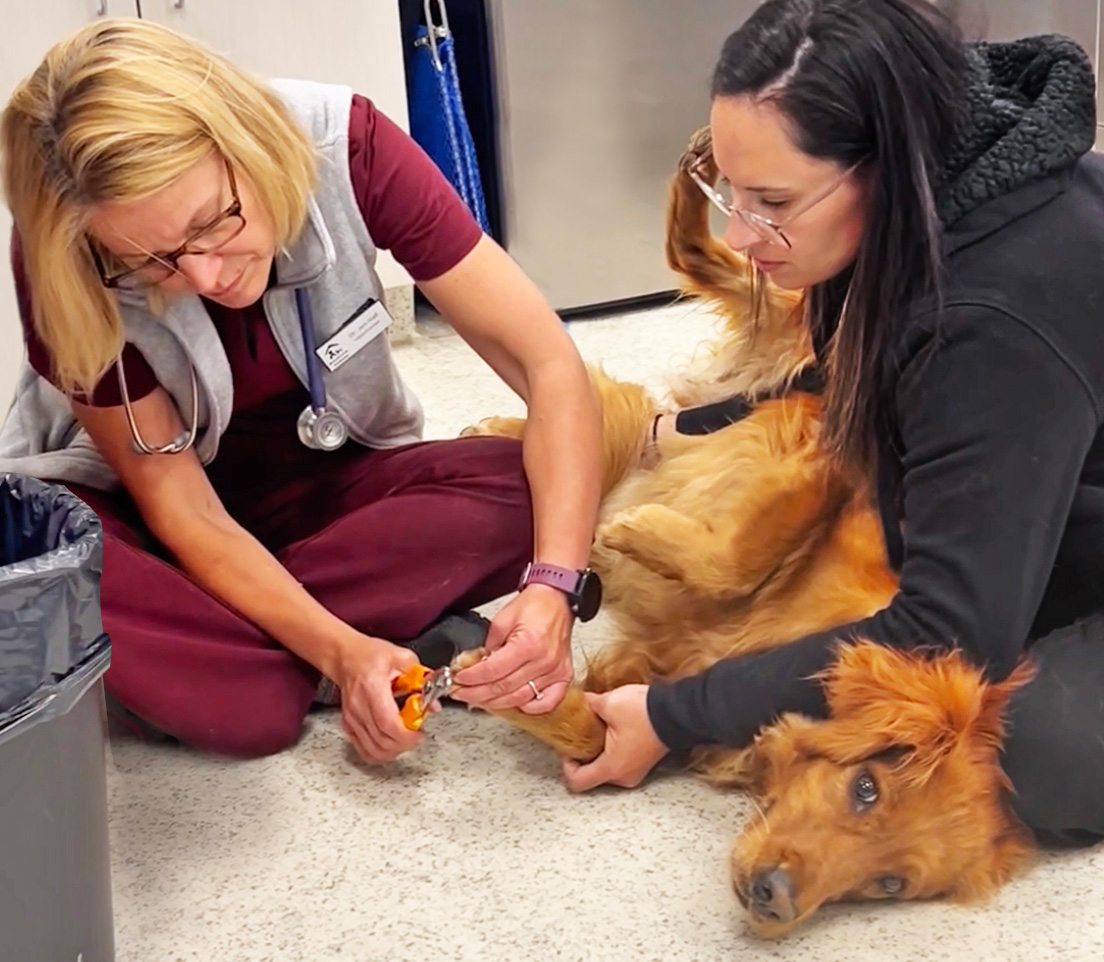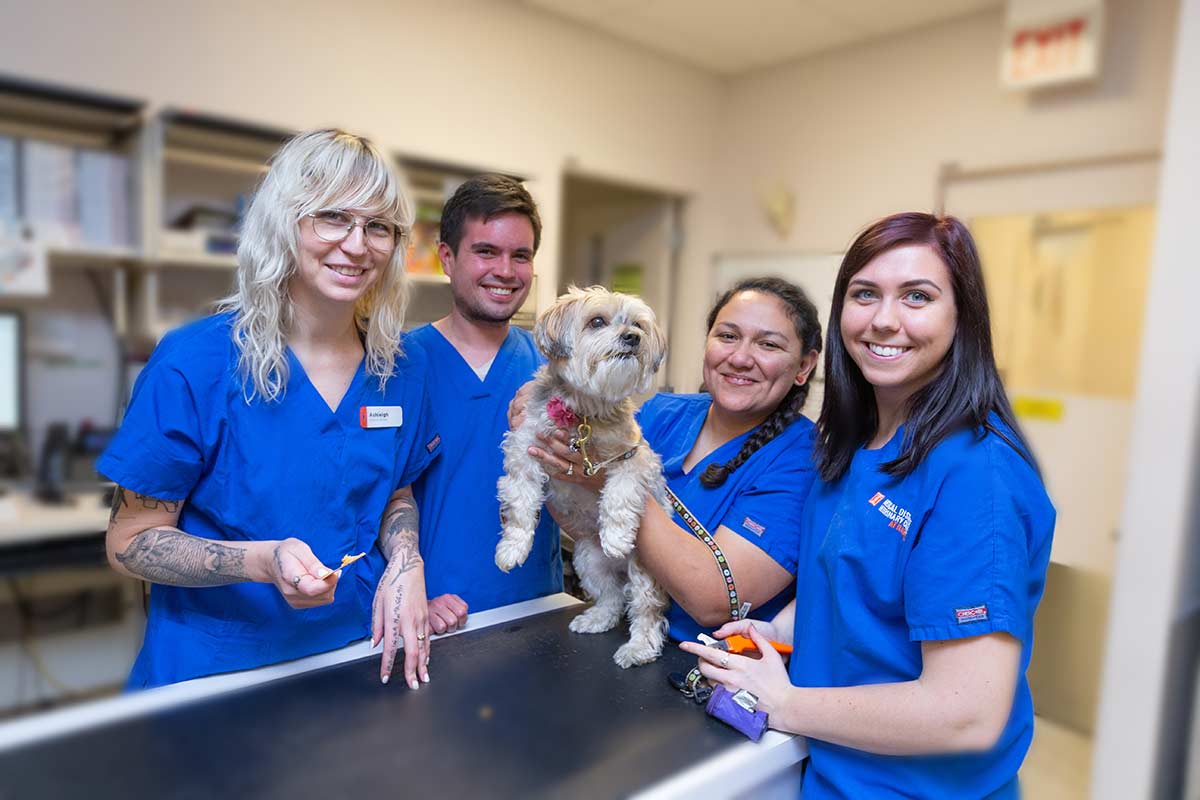Why Pet Rehab Is Crucial: the Benefits of Veterinarian Providers for Your Pet's Recuperation
Pet recovery is an essential part of recovery for pet dogs encountering injuries or disabilities. Veterinary solutions offer important assistance through tailored rehabilitation strategies that attend to specific demands. These plans usually include discomfort monitoring, physical treatment, and nutritional assistance. Recognizing the different aspects of pet rehabilitation can illuminate its significance in boosting recovery end results. What certain benefits do these services supply, and exactly how can they transform a pet's healing journey?
Comprehending Animal Rehab
Animal rehabilitation incorporates a variety of therapeutic methods targeted at recovering the health and performance of hurt or impaired animals. This area integrates numerous strategies, consisting of physical treatment, hydrotherapy, and work-related therapy, customized to meet the details demands of each pet. Recovery professionals analyze an animal's problem, developing individualized therapy strategies that may entail workouts to enhance muscles, enhance mobility, and improve general health. The procedure not only concentrates on physical healing but additionally addresses emotional and behavioral elements. Animals typically experience tension and stress and anxiety following an injury, making mental health and wellness factors to consider crucial in rehab. By developing a helpful environment, specialists can help pets reclaim their confidence and adjust to their new situations. Via routine sessions, pets can experience substantial improvements, eventually causing a better top quality of life. On the whole, comprehending pet recovery highlights its value in promoting recovery and boosting the bond between animals and their owners.
The Function of Discomfort Management in Recovery
Exactly how essential works pain management in the recovery of damaged pets? It plays an essential role in promoting healing and boosting the general health of family pets. Appropriate discomfort administration not only minimizes discomfort however also promotes mobility, making it possible for animals to join recovery tasks necessary for recuperation. When discomfort is efficiently managed, pets have a tendency to respond positively to therapy, leading to quicker rehab outcomes.Veterinarians use different techniques to assess and deal with pain, including medicines, acupuncture, and alternative therapies. By customizing discomfort administration methods to the private demands of each pet, vets can ensure that family pets remain tranquil and cooperative throughout their recovery trip. Decreasing discomfort helps reduce anxiety, which can inhibit recovery and prolong recuperation times. To sum up, effective discomfort monitoring is essential for boosting the healing procedure and improving the high quality of life for damaged pets.
Physical Therapy Techniques for Family Pets
Numerous physical therapy techniques are readily available to help in the rehabilitation of pets recouping from injuries or surgeries (tplo surgery for dogs). These techniques can boost flexibility, relieve discomfort, and promote healing. Therapeutic exercises, for example, help reinforce muscle mass and improve joint function, permitting animals to reclaim their physical capacities progressively. Manual treatment, which consists of massage therapy and mobilization, can ease stress and improve blood circulation, adding to a faster recovery.Other strategies such as easy range of movement exercises urge joint adaptability and reduce rigidity. Additionally, electric stimulation treatment might be used to boost nerves and muscular tissues, advertising recovery and pain relief.Veterinary experts typically customize these methods to every family pet's certain demands, making sure a complete rehabilitation plan. By applying these physical treatment techniques, pet dogs can experience improved lifestyle and a more successful healing from their conditions. The integration of these methods right into rehabilitation programs is necessary for ideal recuperation results
Advantages of Hydrotherapy for Rehabilitation
Hydrotherapy offers substantial benefits in animal recovery, specifically in boosting movement. This water-based treatment advertises pain alleviation while supplying comfort to harmed or recouping animals. In addition, it helps with strength-building workouts that add to total physical recuperation.
Boosted Movement Enhancement
As animals recoup from injuries or surgical treatments, enhanced wheelchair frequently ends up being a primary objective of their recovery. Hydrotherapy works as a beneficial tool in accomplishing this objective. With water-based workouts, animals can participate in low-impact motions that assist in joint wheelchair and reinforce muscles without the stress of weight-bearing activities. The buoyancy of water supports their bodies, enabling boosted variety of activity and flexibility improvement. In addition, hydrotherapy urges much better equilibrium and control, which are necessary for recovering typical activity patterns. Regular sessions can bring about substantial development in a pet's physical capacities, ultimately enhancing their high quality of life. This approach not just aids in healing but likewise advertises a more energetic and satisfying lifestyle post-rehabilitation.
Discomfort Relief and Convenience

Alleviation from discomfort is an essential facet of animal rehabilitation, and hydrotherapy significantly contributes to this procedure. By utilizing water's buoyancy, hydrotherapy decreases joint stress and anxiety and reduces discomfort during motion. This restorative technique provides a comforting environment where pets can take part in gentle workouts without the complete weight of their bodies affecting their healing. The warm water boosts blood circulation, promoting recovery while also encouraging leisure. Furthermore, hydrotherapy sessions can be customized to fulfill the details demands of the animal, making sure optimal comfort. As animals experience decreased discomfort and increased convenience levels, their general desire to take part in rehabilitation activities typically enhances, bring about a more effective recovery trip. Consequently, hydrotherapy acts as an important tool in improving discomfort check this relief and convenience throughout recovery.
Strength Building Workouts
Strength-building exercises play an essential function in the rehabilitation process, with hydrotherapy offering special advantages. This form of treatment uses water resistance to enhance muscular tissue stamina without placing excessive strain on the joints. The buoyancy of water sustains the pet dog's weight, permitting safer movement and increased series of motion. Furthermore, hydrotherapy can improve cardiovascular wellness and promote total health and fitness, aiding in quicker recuperation from injuries or surgical treatments. The regulated environment also decreases the threat of reinjury, making it an optimal alternative for animals calling for recovery. Normal hydrotherapy sessions can lead to noticeable improvements in mobility, toughness, and endurance, ultimately improving the pet dog's lifestyle and capacity to return to regular tasks.
Value of Customized Rehab Plans
Customized rehabilitation plans are important for attending to the one-of-a-kind requirements of each animal, ensuring individualized therapy strategies. These strategies permit efficient development tracking and essential adjustments, promoting excellent healing outcomes. In addition, an all natural approach can improve the total well-being of the pet, promoting a more extensive rehabilitation experience.
Individualized Therapy Approaches
While several rehabilitation programs take on a one-size-fits-all technique, the one-of-a-kind needs of each animal necessitate individualized therapy strategies for perfect healing. Custom-made rehabilitation plans think about various elements, including the pet's species, age, case history, and details injuries or conditions. By customizing treatments, vets can deal with each family pet's one-of-a-kind obstacles, maximizing the performance of the recovery process. Individualized plans might incorporate various modalities such as physical therapy, hydrotherapy, and therapeutic exercises, making sure that the treatment aligns with the pet's abilities and progress. In addition, individualized approaches promote a stronger bond between the family pet and the caregiver, advertising an extra engaging and encouraging recovery environment. Inevitably, personalized therapy is essential for achieving best feasible outcomes in animal rehab.
Progress Monitoring and Adjustments

Holistic Recovery Methods
Holistic recuperation techniques are necessary for efficient animal recovery, as they stress the relevance of individualized therapy strategies tailored per pet's certain needs. This method considers the physical, psychological, and environmental aspects affecting healing. Personalized rehab plans might include a mix of physical therapy, nutritional therapy, and behavioral modifications. By attending to these varied aspects, veterinarians can improve the total wellness of the pet and promote a quicker recovery. Such tailored approaches promote a much deeper understanding of the animal's distinct challenges, leading to much more reliable interventions. Inevitably, all natural healing methods not only enhance physical wellness but additionally contribute to the pet's mental and emotional stability, go to this web-site making certain an extensive rehab experience.
The Influence of Nutrition on Healing
Nutrition plays an essential role in the recuperation process for restoring pets, typically establishing the rate and efficiency of healing. A healthy diet plan provides the required nutrients that sustain tissue repair work, improve the body immune system, and boost general vitality. Healthy protein is specifically crucial, as it aids in muscular tissue rebuilding and healing from injuries. Vital fatty acids, vitamins, and minerals also contribute to lowering inflammation and promoting optimum mobile function.Veterinarians frequently emphasize the relevance of customized nourishment plans, considering each pet's certain demands, age, and health standing. Proper hydration is just as essential, as fluids promote vitamins and mineral absorption and assistance in detoxing. By ensuring that pets get appropriate nourishment, caretakers can considerably boost their opportunities of an effective healing, leading to far better long-term wellness end results. Eventually, nourishment offers as a fundamental aspect in the rehab trip, sustaining pets in reclaiming strength and durability post-injury or illness.
Success Stories: Pet Dogs Who Grew After Recovery
Successful rehab stories abound, showcasing the resilience of pets who have conquered substantial obstacles. Take, for example, Bella, a gold retriever that suffered extreme injuries from an auto accident. With committed veterinary treatment and an extensive recovery program, she regained her wheelchair and went back to her spirited self, much to her proprietor's joy. Max, an elderly pet cat identified with joint inflammation, experienced impressive enhancement via a combination of physical treatment and pain monitoring. His newfound agility permitted him to appreciate his preferred sunbathing areas once more. One more motivating situation is that of Coco, a saved greyhound who got over stress and anxiety with therapy and socializing techniques, allowing her to prosper in her brand-new home. These success stories exemplify the transformative power of pet rehab, emphasizing that with the best support, family pets can not just recover yet lead satisfying lives, enhancing the bonds they show to their family members.
Often Asked Concerns
The length of time Does the Rehab Process Typically Consider Pets?
The rehabilitation process for family pets usually differs based upon the injury or condition, varying from a couple of weeks to a number of months. Individual progression, therapy type, and dedication to exercises greatly influence the overall duration of healing.
Exist Any Type Of Threats Related To Pet Rehab?
Pet rehab may bring risks such as exacerbation of injuries, improper strategies causing pain, or not enough monitoring during recovery. These elements can hinder progress and influence the overall efficiency of the recovery procedure.

Can All Pets Take Advantage Of Recovery Providers?
Not all pets might need rehabilitation, but lots of can benefit greatly. Rehab services can improve wheelchair, minimize pain, and boost total health, especially for those recovering from injuries, surgical procedures, or chronic conditions.
Exactly How Can I Prepare My Pet for Recovery Sessions?

What Signs Indicate My Animal Requirements Rehabilitation?
Indications indicating a pet might need recovery consist of difficulty walking, limping, lowered task levels, unwillingness to jump, or indications of pain. Observing these behaviors can motivate proprietors to look for professional assessment and treatment for their animals.